A Summer in 40°C: Riding EuroVelo 6 from Budapest to the Black Sea
I had already done two 1500km+ solo and self-supported bike rides across Europe in 2022 and 2023. The first trip from Cambridge to Warsaw was tough but achievable due to the cycling-friendliness of the countries I had travelled through. Similarly, riding from Cambridge to Stockholm through Holland, Germany, Denmark and Sweden was also fairly achievable although the Swedish weather in 2023 was atrocious.
In a typically over-confident middle-aged man way, I felt I could do something a little harder.
I decided to try the EuroVelo 6 – Atlantic-Black Sea route from Vienna to the Black Sea. The route looked fantastic, but I wasn’t prepared for how challenging it can be when a EuroVelo route isn’t yet fully developed. I blogged every day after I had finished riding and the ups and downs in all their gory detail can be found here.
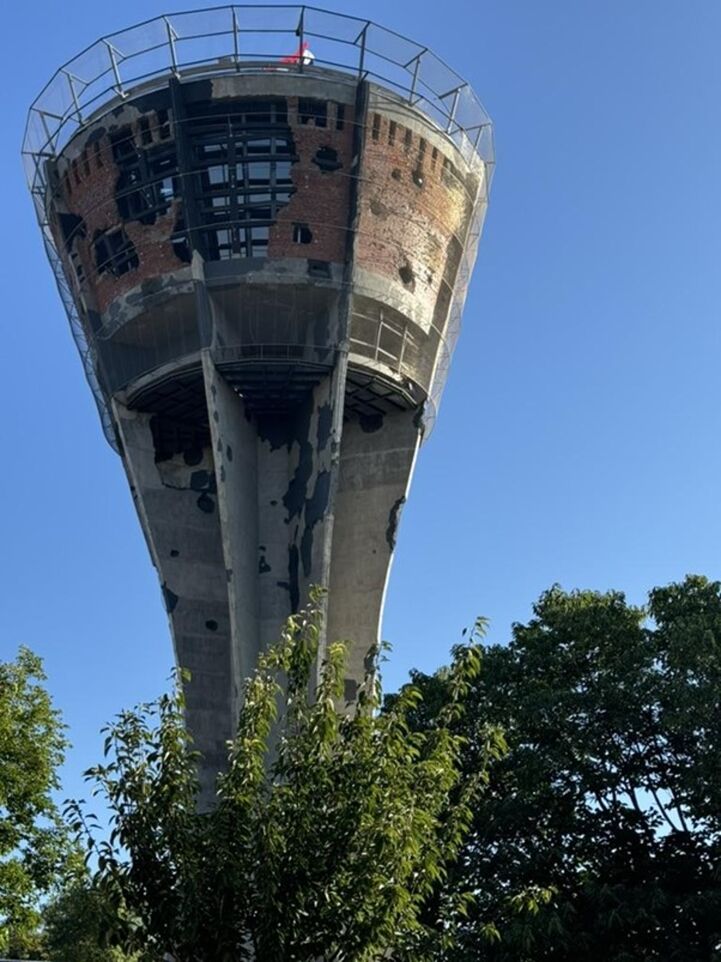
EuroVelo 6 runs from the Atlantic Ocean to the Black Sea passing through 11 countries on the way. I had been reading Misha Glenny’s excellent book about the violent, sad and sorry history of the Balkans and it sparked my interest in riding down the Danube from Austria, through Slovakia, Hungary, Croatia, Serbia, Romania and Bulgaria, to the Black Sea. Unfortunately, like in 2022, geopolitical events ensured that I couldn’t follow the semi-official EuroVelo 6 route since cycling through the middle of a war in Ukraine didn’t seem a sensible thing to do.
That being said, I would still be cycling through a part of the world which was a war zone less than 30 years ago and, unlike EuroVelo 2 – Capitals Route between Cambridge and Warsaw that I had ridden in 2022, EuroVelo 6 is pretty provisional beyond Hungary which meant the roads and routes might not be ideal.
My previous trips I began from my own doorstep. This trip required transporting my bike to the starting point and also getting a bike bag to my final destination to be able to bring my bike back. The logistical challenges on these sorts of trips are daunting. In the end, I had sent my bike bag to a hotel in Bucharest with an approximate indication of when I would arrive and I packed my bike in a cardboard bike box to get it to Vienna. A great tip is to go and ask your local bike shop if they’ve got any cardboard boxes from the new bikes that they sell. Most of them have loads of these which they are more than happy to get rid of.
I set off to Stansted airport for my flight to Vienna early in August and ran straight into a giant omnishambles. My flight was delayed by 18 hours and then eventually cancelled. I had to get a flight to Budapest the following day and that flight managed to leave my bike bag behind in Heathrow. Not a great start. I had to start my trip from Budapest rather than Vienna and I missed one of the best bits of EuroVelo 6 which runs between these two cities.
However, starting in Budapest means you start right on the river.
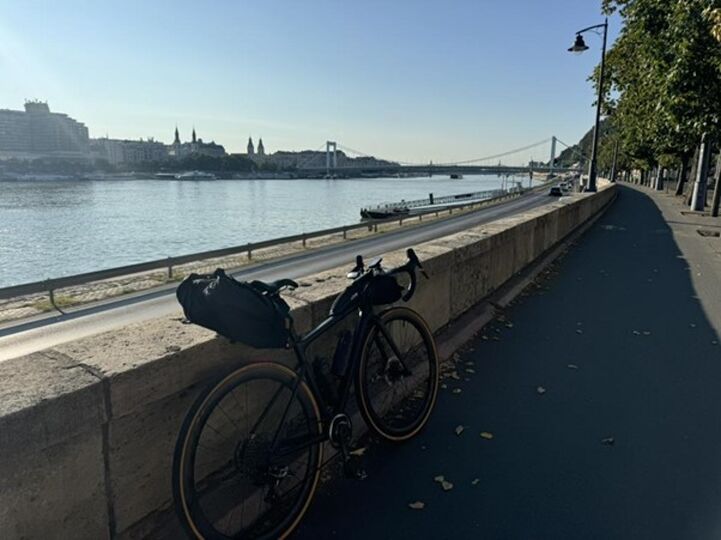
As a rule, getting into and out of big cities is a challenge to the EuroVelo route designers: Budapest is no exception to that rule. There were some pretty rough parts of the route – although nothing compared to what was to come in Romania – involving rutted paths and what appeared to be somebody’s back garden. However, finally EuroVelo signs directed me up onto the Danube flood dykes which are such a feature of this part of EuroVelo 6.

If you’re comfortable riding on gravel this really is lovely riding. Occasionally the Hungarian government has paved the top of the dykes but it’s mostly sandy gravel. A high spec racing bike might struggle but any bike that you’d sensibly use for a long distance trip will be fine.
Of course, it’s hard to get a traffic free route through countries where there isn’t a whole lot of official cycling infrastructure. Sections on roads can be…worrying sometimes. And when there aren’t worrying sections on busy roads, sometimes EuroVelo 6 just peters out in the middle of a field.
Across the border in Croatia, route runs straight through Vukovar which was the site of a siege in 1991 during which the 36,000 Serbs shelled the 1,800 Croatian defenders for 87 days. It was the most brutal and protracted land battle in Europe since 1945. Of course, the conflict in Ukraine has since taken that sad title.
Although the town was totally destroyed and has been mostly rebuilt there are still signs of war.
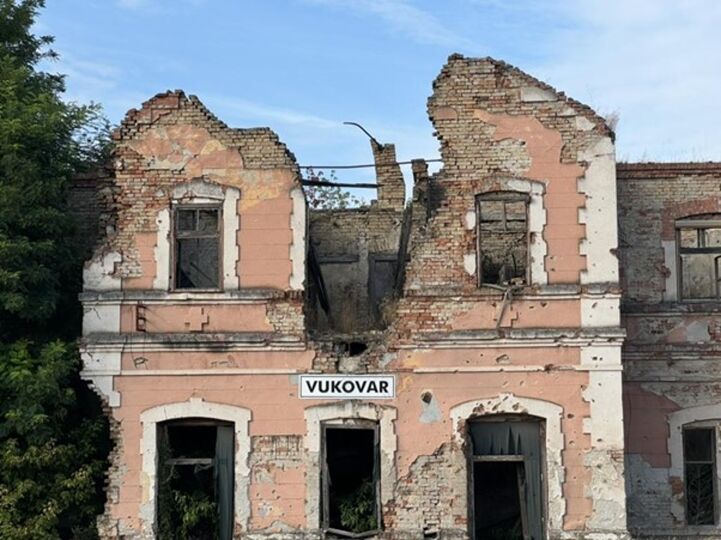
However, it was Victory Day in Croatia on the day I cycled into it and stayed the night. There were people celebrating everywhere and that dispelled my rather sombre mood.
One of the great joys of long-distance cycling is crossing borders on a bike. I don’t know why but it feels…really adventurous. Between Hungary and Croatia which are both in Schengen, the border is non-existent, but Serbia is not in the European Union and therefore you have to go through the usual passport and customs formalities.
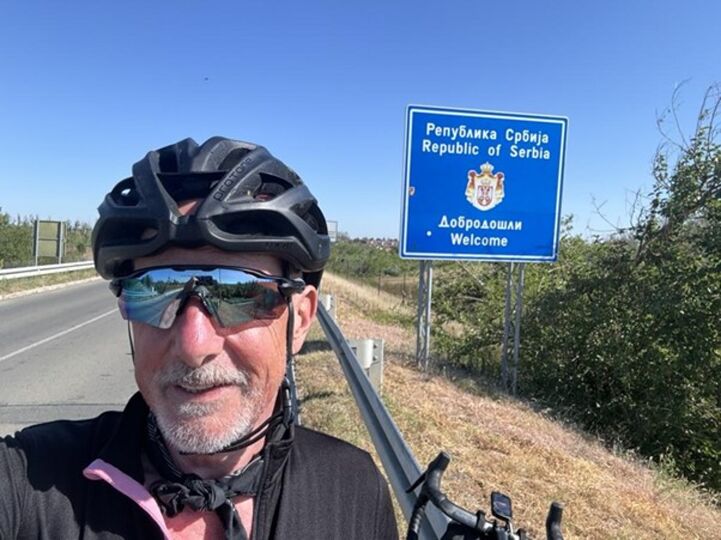
EuroVelo 6 in Serbia follows the Danube towards Novi Sad where there is one of the most iconic views of the trip. A defunct helicopter used as an advertising prop.
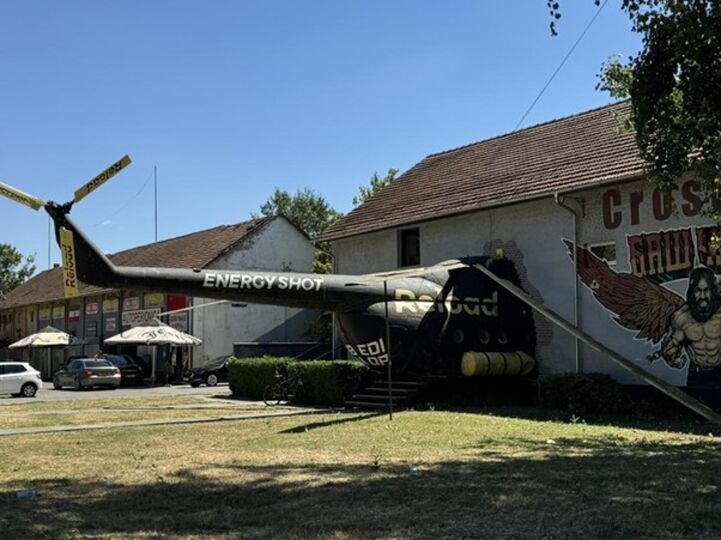
After crossing the Danube at Novi Sad, it was a long and hot cycle into Belgrade where I had decided to have a rest day. For me, rest days are an important feature of long-distance solo cycling trips. It’s an opportunity to spend time sightseeing, going to museums, washing or replacing clothes and, most importantly, not turning your legs constantly for 10 hours. I wrote a blog piece about my day in Belgrade which you can read here.
After Belgrade, the EuroVelo 6 rather peters out. There’s no signage and I really depended on my Garmin route. The GPX routes on the EuroVelo website are complicated by the multiple possible routes at this point (left side of the Danube, right side of the Danube) and therefore it requires a lot of work to get Garmin routes to work properly.
Getting out of Belgrade was very difficult. The route runs over the Pančevo bridge, which is fast, busy and entirely lacking in any cycling infrastructure whatsoever. I suspect I was closer to death on this part of the route than at any other time. If you can convince a taxi driver to take you and your bike from central Belgrade to the other side of the river, I would definitely recommend that. However, after that buttock clenching ride of fear, it was back on the long straight Danube river dykes with the added thrill of some excitable and friendly goats to avoid.
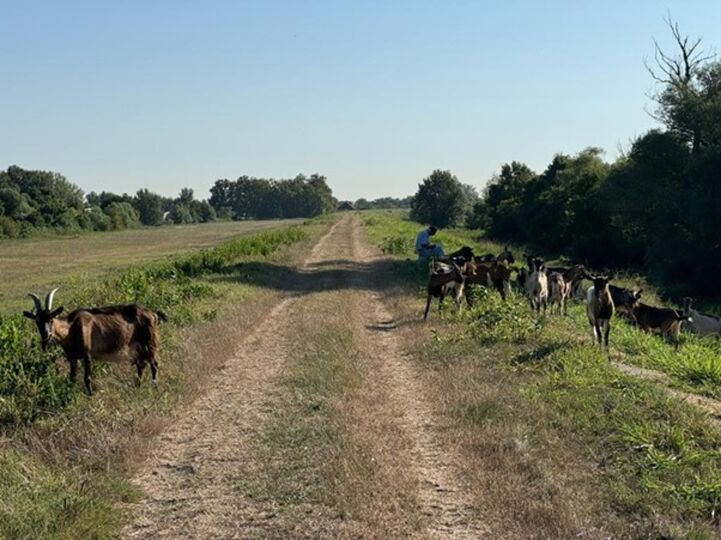
A long morning on the dykes got me to the ferry at Ram which is a very cute and scenic way of crossing the Danube. Unfortunately it only runs three times a day and if you miss it, you’ll be waiting a long time.
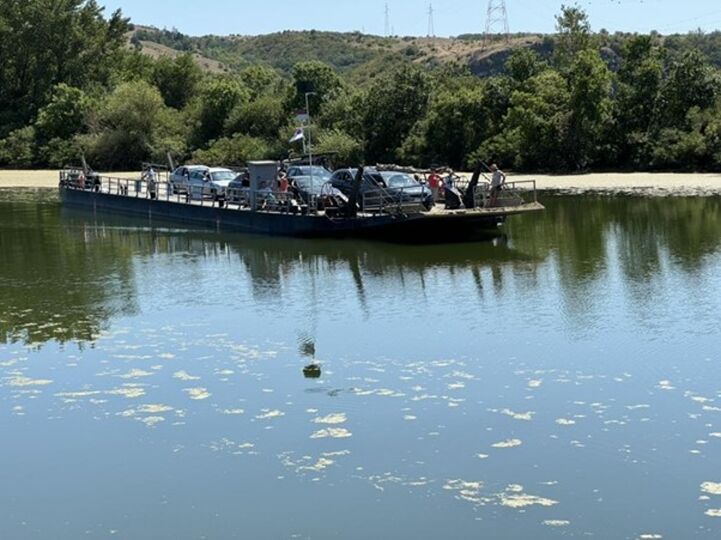
I stayed in a funky barely 2 star hotel in Vinci that evening and set out the following morning to cycle through the Iron Gates. This is one of the most beautiful sections of the entire EuroVelo 6 and is definitely one of the highlights of cycling down the Danube. The road is new and it’s incredibly enjoyable despite going through some very scary tunnels – don’t forget your lights!
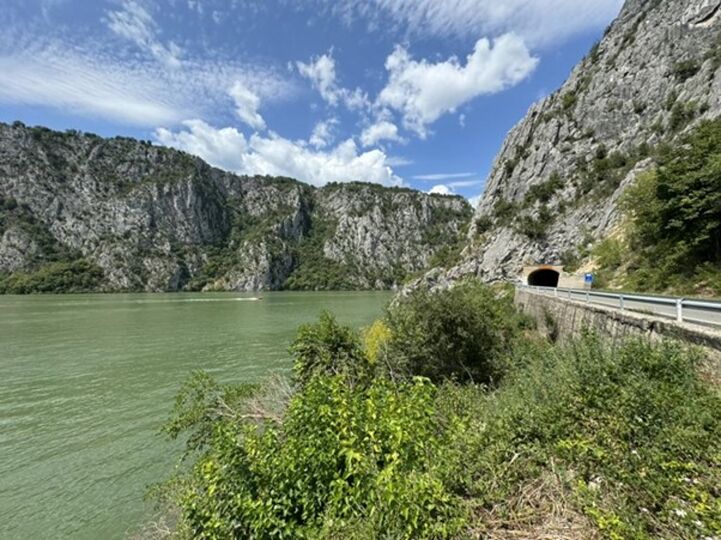
I had decided to once again cross the Danube but this time on the top of a hydroelectric powe station and cross into Romania. I was now around half-way. Yet, while riding from Budapest to here had been tough by itself, this last leg, almost entirely in Romania and on undeveloped routes, was to push me to the limit.
The days were long and hot in Romania. The temperatures were mostly above 40°C from about 10am in the morning which certainly saps your strength.
Unfortunately, the constraints of riparian geography and economics means that there is mostly one big and busy road running near the river and the lorries thundering towards the Friendship Bridge between Romania and Bulgaria ensured that some of the stretches were really very concerning. EuroVelo are working with Romanian and Bulgarian cycling organisations to develop the route here and hopefully those efforts will bear fruit. But until then, you need to take a lot of care.
It is possible to get off the main roads for some of the journey and one ends up in very rural parts of Romania.
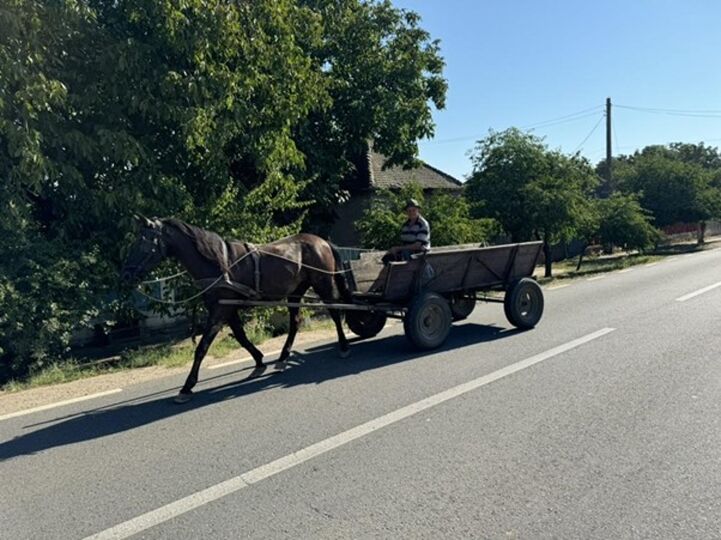
Wary cyclists will realise that the presence of lots of horses on the roads will result in the inevitable droppings which have to be skillfully avoided… Although horse manure isn’t fun to avoid, it’s considerably better than the crazy junkyard dogs which occasionally come zooming out of gardens and driveways. The lack of traffic which makes the roads so much more fun than the main roads also ensures that dogs which chase cyclists haven’t had the evolutionary pressure of contending with 18-wheel juggernauts.
Along the north bank of the Danube, the temperatures started to rise steadily. Every day, by lunchtime the temperature was in the 40°s. The iron rule of long-distance cycling is that you must never run out of water. Luckily in Romania, there are little villages every 20km or so which (usually) have a supermarket which takes card payments. I would load up on 1.5l of water at a supermarket, cycle 20km and then at the next one I would dump the water remaining in my water bottles – which in an hour became the temperature of bath water – and buy new water. They were long days.
Due to a lack of accommodation options on the Romanian side, I crossed the Danube twice to stay in Bulgaria. The first was the impressive (and cycle friendly) New Europe Bridge– which, it turned out, was the cause of the heavy traffic of Bulgarian and Turkish lorries on the Romanian side. I stayed in Vidin and then crossed back over to continue to the Friendship Bridge which is definitely not cycle friendly.
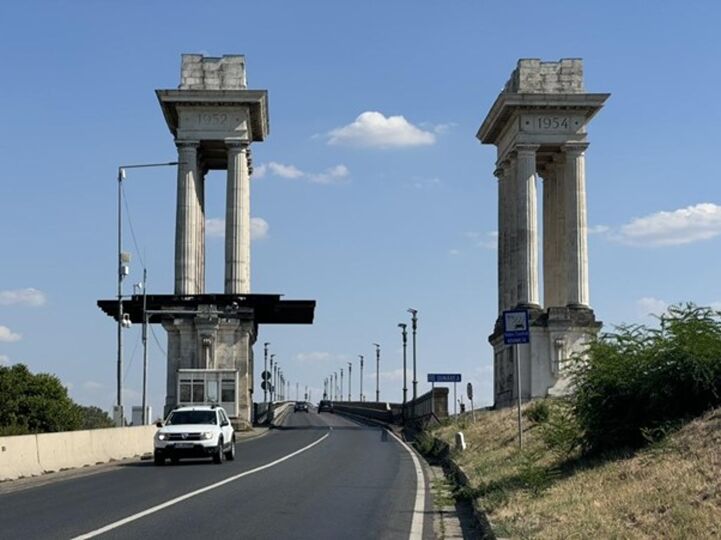
This somewhat challenging bridge crosses from Giurgiu in Romania to Ruse (or Русе as it is in Cyrilic) in Bulgaria.
That evening I stayed in a tower block hotel straight out of 1960s communist architecture playbook. Gigantic, ugly and with four restaurants but only one was open and the menu was also a throwback to the communist era.
By this point I had probably had enough. In the previous two days I had been on the edge of what I was capable of mentally and physically. Extreme heat, difficult cycling routes with heavy traffic, occasionally scary moments in some of the more isolated Romanian villages. I looked at the route for the following day and realised it was the longest day on the route and had a lot of climbing in it. I bowed to the inevitable and decided to take a taxi from Ruse to Silistra. Sometimes discretion is the better part of valour and for €80 I was whisked in air conditioned comfort along Bulgarian Route 21. To be honest, this was the best decision of the entire trip. It was hotter today than in previous days and looking at Route 21 out of the window of the taxi, I offered up a silent prayer of thanks that I had made the right decision. Despite the best efforts of EuroVelo and the Bulgarians, this would have been a terrifying ride on a busy road with no space for bikes.
The upside was that I got to spend a morning in Ruse looking at its (somewhat underwhelming) attractions and an afternoon in Silistra going round its much more exciting collection of museums. I was staying at what was billed to be the best five star hotel in Silistra. Although the food and the accommodation weren’t worth five stars, the hotel made up for it with a fabulous terrace overlooking the Danube where I could gaze for the final time at this amazing river.
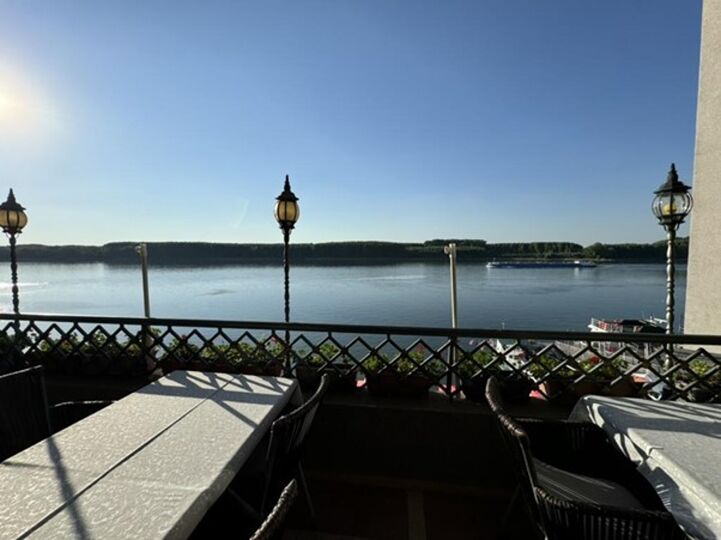
I had one day to go. The final day took me off the EuroVelo 6 route because I’d decided to head east and get to the Black Sea at Constanța. Silistra is on the Bulgarian/Romanian border and so 10 minutes after leaving the hotel, I was in Romania and pounding out the kilometers through an increasingly hot and parched landscape. Foolishly I hadn’t really realised when planning the route that today was the day with the most climbing in it. There are no mountains, there are just an endless series of rolling hills each of which became more and more difficult to climb as the day progressed. The traffic got busier as I got closer to Constanța and it was only a bloody minded determination to finish this on my bike that got me through a couple of motorway style junctions and some hairy traffic.
And then, almost without warning, there was the Black Sea.
The sense of relief and accomplishment in setting a crazy goal of cycling from Vienna to the Black Sea and actually getting it done is… indescribable. All the memories of terrible traffic, difficult routing, appalling hotels and dangerous dehydration seem to disappear in that moment. This is the reason why one does long distance cycling. Of course the opportunity to see countries and parts of the world that one wouldn’t normally do is fascinating but to be able to say to yourself, “I did this” is worth all the trials and tribulations.
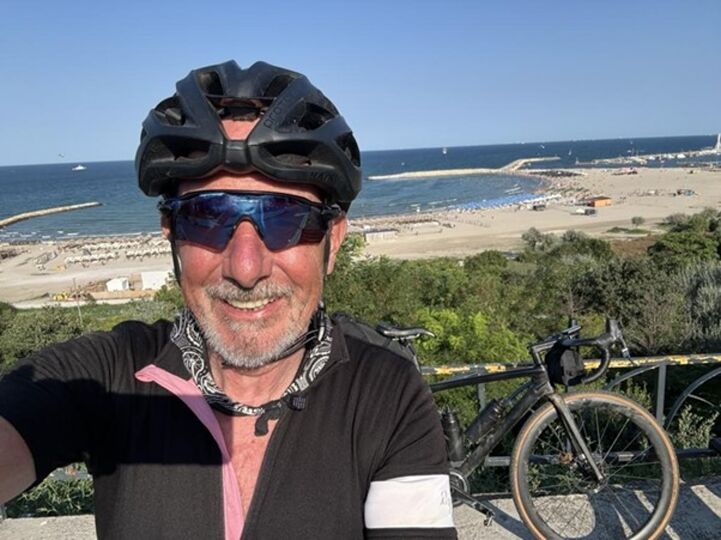
I took the train to Bucharest and spent a day there. Romania has an appalling and difficult history from Vlad Țepeș (Vlad the Impaler) through the two world wars and culminating Nicolae Ceaușescu’s 24 year rule of terror and destruction. I always find it useful and informative to read about the places I’m cycling through before going. Paul Kenyon’s book is essential reading before going to Romania and helped me understand a lot of the history of Bucharest.
Is EuroVelo 6 from Budapest to the Black Sea a good route? The countries I travelled through are not Denmark or Holland in terms of cycling infrastructure. They’re not even the UK or Poland. The countries are poorer and haven’t invested as much in infrastructure (yet?) and I certainly wouldn’t recommend it as an introduction to long distance self-supported cycling. However, EuroVelo is working hard with the cycling federations in each country to build up the infrastructure and signage. If you’re more accustomed to this sort of travel and have a reasonable degree of physical and mental resilience I definitely recommend this route. The landscape is varied and you pass through many different countries with extraordinarily complex and difficult histories. It is truly fascinating.
The only difficulty is deciding which EuroVelo route to take next year…
Written by Ewan Kirk